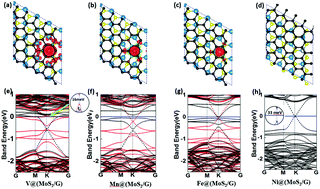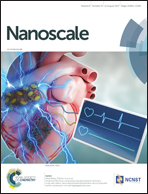Half-metallic properties of 3d transition metal atom-intercalated graphene@MS2 (M = W, Mo) hybrid structures†
Abstract
The energetics and electronic and magnetic properties of G/MS2 hybrid structures embedded with 3d transition metal atoms, TM@(G/MS2) (G = graphene; M = W, Mo; TM = Sc–Ni), have been systematically studied using first-principles calculations. TM atoms were found to be covalently bound to two-sided graphene and MS2 layers with sizable binding energies of 4.35–7.13 eV. Interestingly, a variety of electronic and magnetic properties were identified for these TM@(G/MS2) systems. Except for TM = Ni, all other systems were ferromagnetic, due to exchange splitting of the TM 3d orbitals. In particular, four TM@(G/MoS2) systems (TM = V, Mn, Fe, Co) and three TM@(G/WS2) systems (TM = Mn, Fe, Co) were half-metals or quasi half-metals, while Ni@(G/MoS2) and Ni@(G/WS2) were semiconductors with bandgaps of 33 and 37 meV, respectively. Further quasi-particle scattering theory analysis demonstrated that the origin of semiconducting or half-metallic properties could be well understood from the variation in on-site energy by the transition metal dichalcogenide substrate or the different on-site scattering potential induced by TM atoms. Our findings propose an effective route for manipulating the electronic and magnetic properties of graphene@MS2 heterostructures, allowing their potential application in modern spintronic and electronic devices.



 Please wait while we load your content...
Please wait while we load your content...